(来自中国的读者们可以通过以下链接访问AIIA微信公众号上发表的本文翻译: https://mp.weixin.qq.com/s/U88S5m9lyhS1erf_Bw1KjA)
Background: As part of our mission to advocate for EB-5 investors, AIIA regularly files Freedom of Information Act (FOIA) requests for information from U.S. Citizenship and Immigration Services (USCIS) on topics that affect the EB-5 immigrant investor community. Because USCIS does not provide timely responses to our FOIA requests, AIIA regularly litigates against them to compel the agency to respond. In response to our most recent lawsuit, USCIS has provided us with data on the filing, approvals, and denials of post-RIA investor petitions as of January 2025. AIIA Members may request a full copy of government information provided to AIIA. We ask that you consider donating to help us obtain more such data. AIIA is grateful to Alexandra George of the Galati Law Firm for leading our FOIA litigation against USCIS in order to obtain this data.
We normally share the full copy of government responses to our FOIA data with AIIA Members, but this time we have made it available to anyone for downloading (link at the bottom of this blog).
Following up on our last blog post, where we shared the latest data on the inventory of petitions, we will now share the I-526/I-526E petition adjudication data for post-RIA EB-5 petitions. This data was queried in February 2025 by the Office of Performance and Quality of USCIS. We re-emphasize: this is official data from USCIS, which the agency does not typically release. It is highly important for existing and potential EB-5 investors to get a realistic understanding of USCIS’s adjudication efficiency.
In our previous blog post, we published data on the inventory of petitions received by USCIS until January of 2025, which are categorized by the petitions’ month of filing and country of chargeability. The analysis we are now sharing explains how many of those petitions have actually been adjudicated.
Due to the limited number of post-RIA I-526/I-526E adjudications, only the two biggest EB-5 country-markets (Mainland China and India) and the “Rest of the World” market have enough data points to make a statistical analysis plausible. We are open to suggestions regarding the kinds of data that may be queried from FOIA disclosures we obtain. See the bottom segment of this blog for more.
Why is this particular dataset so important?
For many post-RIA investors, the most common question they may ask their investment issuer, attorney, agent, or broker is “When will my petition be approved?” Many EB-5 service providers will offer their guesstimate but it’s impossible to provide an accurate answer to that question. USCIS’s efficiency is already declining, as pointed out by renowned EB-5 blogger Suzanne Lazicki.
The next logical thing for any investor is to try and figure out “How many petitions are ahead of mine?” or “How many petitions ahead of mine have been approved, out of everyone that has already invested?”
Approval Rate Analysis
The following chart is sourced from our previous blog:
Total number of I-526/I-526E petitions filed between April 1, 2022 and January 31, 2025 by TEA category and country of chargeability (latest statistics per USCIS data, queried in February 2025 in response to AIIA’s FOIA request)
| China | India | Rest of World | Total | % Total | |
| Rural | 2,684 | 847 | 798 | 4,329 | 44% |
| High Unemployment | 2,380 | 883 | 1,928 | 5,191 | 53% |
| Infrastructure | 0% | ||||
| Other | 98 | 60 | 200 | 358 | 4% |
| Total | 5,162 | 1,790 | 2,926 | 9,878 | 100% |
| % Total | 52% | 18% | 30% | 100% |
The two charts below reflect the approval and denial data of those same petitions:
I-526/I-526E petition approvals for petitions filed between April 1, 2022 and January 31, 2025 by TEA category and country of chargeability (latest statistics as per USCIS data queried February 2025 in response to AIIA FOIA request)
| China | India | Rest of World | Total | |
| Rural | 729 | 248 | 149 | 1126 |
| High Unemployment | 79 | 112 | 160 | 351 |
| Infrastructure | ||||
| Other | 9 | 9 | 24 | 42 |
| Total | 817 | 369 | 333 |
I-526/I-526E petition denials for petitions filed between April 1, 2022 and January 31, 2025 by TEA category and country of chargeability (latest statistics as per USCIS data queried February 2025 in response to AIIA FOIA request)
| China | India | Rest of World | Total | |
| Rural | 27 | 1 | 2 | 30 |
| High Unemployment | 5 | 5 | 10 | |
| Infrastructure | ||||
| Other | 4 | 3 | 14 | 21 |
| Total | 36 | 4 | 21 |
Adjudication Trend by TEA Category
Global Post-RIA I-526/I-526E Adjudications (approvals and denials), by Visa Set-Aside Categories and Month of Filing
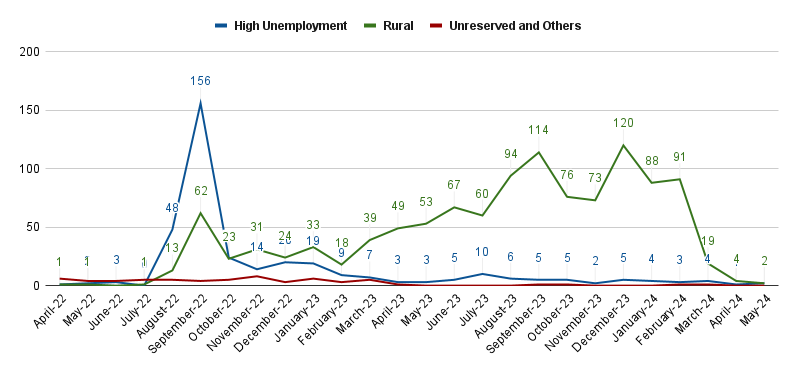
The X-Axis (horizontal line on the graph) represents month and year of the petition priority date and the Y-Axis (vertical line on the graph) represents the number of petitions that have been adjudicated for that month as of January 2025.
China Rural vs HUA Adjudications
Rural vs High Unemployment I-526/I-526E Adjudications (approvals and denials) from Mainland China
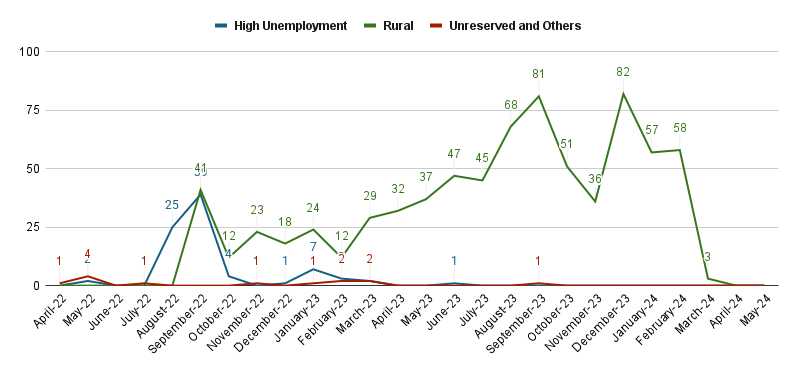
Please note the X-Axis represents month and year of the petition priority date and Y-Axis represents the number of petitions filed in that month by China born petitioners that have been adjudicated as of January 2025.
If we compare the number of petitions adjudicated by their respective priority dates with the number of petitions that were actually filed in the same months, we can calculate the percentage of adjudication completion for each month:
India Rural vs HUA Adjudications
Rural vs High Unemployment I-526/I-526E adjudications (approvals and denials) from India

Please note the X-Axis represents month and year of the petition priority date and Y-Axis represents the number of petitions filed in that month by India born petitioners that have been adjudicated as of January 2025.
If we compare the number of petitions adjudicated by their respective priority dates with the number of petitions that were actually filed in the same months, we can calculate the percentage of adjudication completion for each month:
Comparing the percentage of filed I-526/E Adjudicated as of January 2025 (All countries)
Putting all this data together we can get a better understanding of how USCIS is prioritizing adjudication across the set aside categories and across countries.
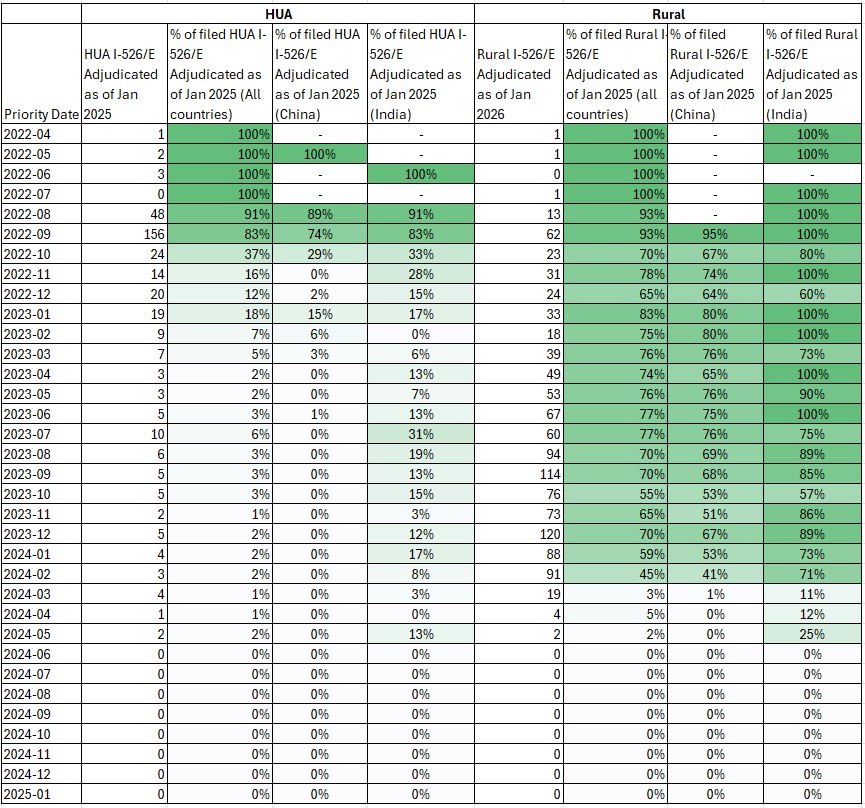
What can we learn about adjudication trends from this data?
The two key takeaways regarding adjudication efficiency from our analysis are:
1. There are no significant differences in adjudication timelines between countries.
2. However, there are notable disparities between the High Unemployment Area (HUA) and rural categories. While most of the HUA petitions filed in 2022 have been adjudicated, very few of those filed in 2023 have been picked up for review
The observations below are based on the current data and could likely change once we get the next set of data:
The Rural half of the chart shows that rural adjudications seem to be less First-in-First-Out than High Unemployment. From the approval/denial numbers, it is interesting to note how incredibly low the denial rate for post-RIA investors is in comparison to pre-RIA petitions.
What does this mean for the future?
As an organization dedicated to supporting immigrant investors, AIIA wants to empower you with data that you may interpret yourself. However, our prediction, based on the raw data, is that the rural category is likely to see a priority date imposed on the Visa Bulletin much sooner than the High Unemployment category. This is not without precedent. During an AIIA webinar with multiple EB-5 experts in 2023, we hypothesized this exact scenario.
It is of concern to us that USCIS has barely made a dent in the number of HUA petitions that are pending. For instance, Mainland China petitioners have 756 out of their 2,684 rural petitions adjudicated, but only 84 out of their 2,380 HUA petitions have been adjudicated as of January 2025. At this rate of adjudication, HUA investors from any country could take years to actually obtain their conditional green card.
Complete Dataset and future FOIA requests
As a nonprofit organization, AIIA invests significant time and resources in acquiring, analyzing, and disseminating this data. We rely solely on donations to sustain our efforts, including funding FOIA litigation, lobbying, and daily operations. We urge anyone who values our work to enhance transparency in the EB-5 program to consider supporting us by making a donation or membership contribution. Your support is vital in ensuring that we can continue to advocate for transparency and equity in the EB-5 program, benefiting investors and industry professionals alike.
Usually, we only share the full copy of government responses to our FOIA inquiries with AIIA Members. The main reason for this restriction is because acquiring each batch of data requires significant time, money, and effort to obtain. Furthermore, preparing quantitative and qualitative analysis and preparing translations for the wider EB-5 community takes up considerable time for our staff.
This batch of I-526/I-526E approval and rejection data is the EB-5 community’s first in-depth glimpse into USCIS’s post-RIA adjudication numbers. We have made the decision to publish it to the wider community. We hope that this data will help stakeholders across the EB-5 ecosystem and enhance our mission of making the EB-5 program more transparent for all. Please consider donating to help us, even if it’s a small amount. You can download the full dataset of the approval/denial data that we obtained from our FOIA request here.
If you have a suggestion or request for specific data that you would like to see from the U.S. government, please submit it to us through our contact form. We regularly file FOIA requests with USCIS to obtain information that is vital to the larger immigrant community, and wish to help as many stakeholders as possible.

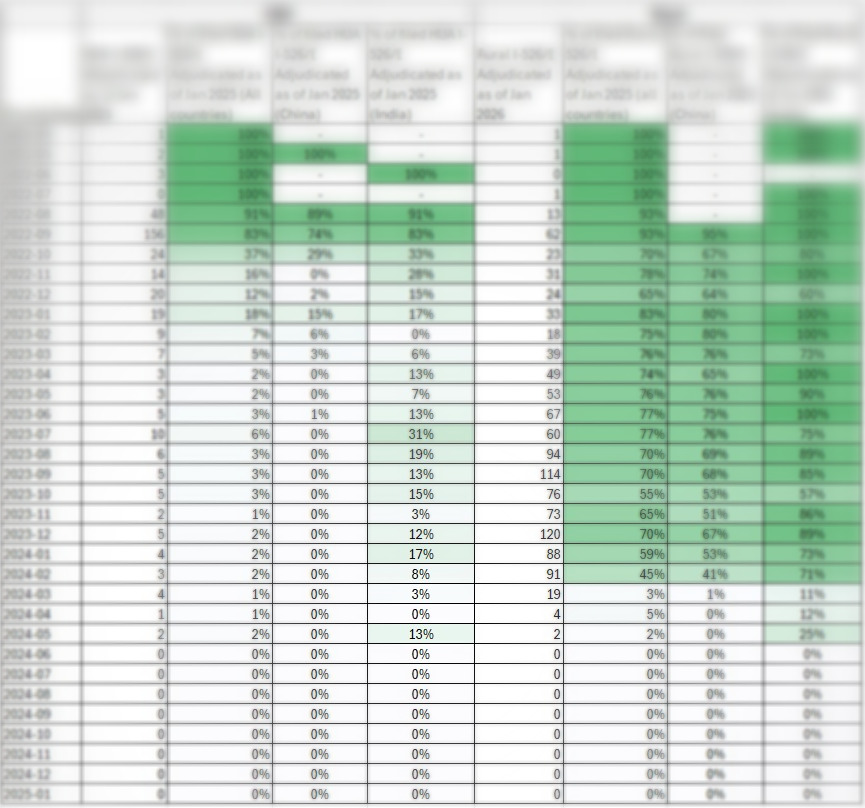
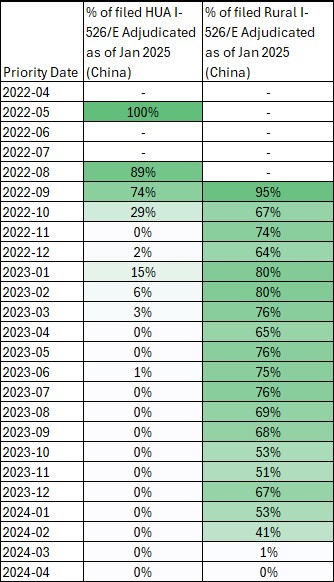

Thanks for the data. Based on HUA investments from the rest of the world category, do we interpret from the data that adjudications are taking approximately 2.5 years to reach a decision? And for rest of the world, does it vary much depending on the country from which the application is being made and is it possible to get country specific data?
According to the data, it’s rather interesting that HUA adjudications for India progress about 50% more quickly than those for the rest of the world, and nearly 280 % faster than China’s.
According to the data, it’s rather interesting that HUA adjudications for India progress about 50% more quickly than those for the rest of the world, and nearly 280 % faster than China’s..